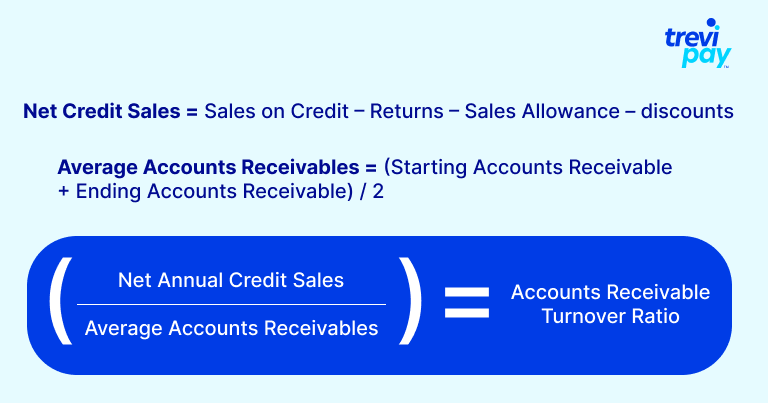When it comes to financial management, few metrics come close to the importance of the Accounts Receivable Turnover Ratio. It is crucial in determining how efficiently a business is collecting payments from customer credit purchases during a specific period of time. Increasing your Accounts Receivable Turnover Ratio, can result in enhanced financial stability, improved profitability and sustained long-term growth.
Improving the Accounts Receivable Turnover Ratio also directly influences cash flow, meaning businesses can use it to forecast cash inflows. Using the ratio, companies are better equipped at cash flow management and ensuring adequate funds are available for operations, investments and growth initiatives. An optimal Accounts Receivable Turnover Ratio can result in improved debt management and stakeholder confidence, which in turn improves the overall financial health of the company. Keep reading to learn how to calculate Accounts Receivable Turnover Ratio, and why you should care about it in the first place.
What is Accounts Receivable Turnover Ratio?
The Accounts Receivable Turnover Ratio is a financial measurement used to determine how efficiently a company collects payments from its customers during a time period, typically a year.
The Accounts Receivable Turnover Ratio is very important in assessing the effectiveness of a company’s credit policies and collection efforts. If a company is producing a quality turnover ratio, then that means that a sufficient amount of accounts receivable is being collected and the credit policies and collection efforts in place are effective.
Because it provides visibility into receivables management, the Accounts Receivable Turnover Ratio provides businesses with an accurate indication of how healthy their cash flow is.
Why is the Accounts Receivable Turnover Ratio Important?
The Accounts Receivable Turnover Ratio is crucial in the financial analysis and decision-making of a company. By measuring the number of times a company collects its average accounts receivable balances in a certain period of time, the Accounts Receivable Turnover Ratio helps businesses analyze the financial state of their cash flow and whether decisions need to be made to further optimize the ratio.
By describing how efficiently payments from account receivables is transferred into the company as cash, the Accounts Receivable Turnover Ratio can provide valuable insight on a company’s liquidity and overall financial performance. A higher turnover ratio means that companies are turning more outstanding payments into usable money, which leads to a healthier cash flow, high liquidity and demonstrates that the company is at a smaller risk of being in bad debts.
What is a Good Accounts Receivable Turnover Ratio?
Although higher Accounts Receivable Turnover Ratios are considered to be better, a “good” ratio depends on industry standards, business models and other circumstances. Industries with higher-value transactions and longer sales cycles, like construction, will naturally have lower Accounts Receivable Turnover Ratios because payment collections take a long time. Meanwhile, industries with shorter sales cycles and lower-value transactions, like retail, will be expected to have higher turnover ratios because payment collections are quicker.
A company with a turnover ratio of 5 in the construction industry would be satisfied with their credit and collection procedures if the industry average was around 3. However, a company with a turnover ratio of 5 in the retail industry should change their policies and procedures if the industry average was around 7. Before assessing how your business compares to the rest of the industry, you need to learn how to calculate Accounts Receivable Turnover Ratio.
Accounts Receivable Turnover Ratio Formula and Calculation
The Accounts Receivable Turnover Ratio is the net credit sales divided by the average accounts receivable. Net credit sales is the total sales made on credit during a time period minus any sales returns or allowances. The average accounts receivable is the average balance of accounts receivable over that same time period. To find the average accounts receivable, you would need to add the starting accounts receivable balance in the beginning of a time period with the final accounts receivable balance in that same time period and then divide that sum by 2.

For example, let’s say that a company had $3,200,000 in credit sales for the year and had an average accounts receivable balance of $400,000 throughout that same year. To find your Accounts Receivable Turnover Ratio, you would need to divide 3,200,000 by 400,000. The quotient is 8, so the company is collecting its accounts receivable 8 times during the time period (which would be a year in this example).
High vs. Low Accounts Receivable Turnover Ratio
A high Accounts Receivable Turnover Ratio can indicate that a company has strict yet effective credit policies, leading to highly efficient payment collections from customers. Firm policies and persistent payment collection, such as credit checks on customers before extending credit or regularly updating customers on overdue accounts, will lead to higher turnover ratios.
However, a low Accounts Receivable Turnover Ratio shows potential issues with how the business conducts their credit management and the payment behavior of their customers. Companies with a lower turnover ratio can be dealing with delayed customer payments, inefficient credit policies that lend credit to risky customers, higher costs associated with collecting receivables and other factors.
Tips on How to Improve Your Accounts Receivable Turnover Ratio
When it comes to improving your Accounts Receivable Turnover Ratio, tightening credit policies and improving collection processes are key to making sure more outstanding payments are collected. Leveraging technology and automation to improve your ratio not only boosts operational efficiency but also enhances customer satisfaction, reduces costs and strengthens financial control.
Implementing TreviPay’s solutions provide these benefits and more by offering advanced automation, invoicing, risk management and payment solutions.
Tightening Credit Policies
Companies can review and adjust credit policies by regularly conducting credit checks and setting credit limits to ensure that customers remain creditworthy. By systematically conducting checks and setting limits, businesses can enhance cash flow predictability, reduce bad debt exposure and foster stronger customer relationships based on mutual trust and accountability.
Improving Collection Processes
Businesses can effectively streamline their collection processes by implementing timely invoicing including using tools like eInvoicing and good dunning processes. Dunning is the process of sending reminders to inform and alert customers who have failed to pay their invoices. By clearly communicating with customers about outstanding payments, businesses can strengthen customer relationships while also optimizing cash flow and supporting long-term growth and profitability.
Leveraging Technology and Automation
As the economy becomes increasingly digital, using technology to automate invoicing and payment tracking can drive efficiency, enhance customer satisfaction and support sustainable growth for businesses across various industries. TreviPay’s API-first solutions, such as their automated invoicing, Einvoicing, A/R receivable automation and integration systems, can facilitate better accounts receivable management and improve the turnover ratio.
Enhance Your Accounts Receivable Management with TreviPay
The Accounts Receivable Turnover Ratio lists the amount of accounts receivable balances collected during a specific amount of time. The ratio indicates a company’s operational efficiency, cash flow management capabilities, credit risk exposure and overall financial health. Although a good ratio depends on the industry and the length of typical sales cycles, a higher ratio is generally seen as more optimal.
Using TreviPay’s solutions to manage and automate accounts receivable, businesses can lower DSO, enhance their financial performance, mitigate risks and sustain long-term profitability.
If you want to improve your business’s financial health, explore how TreviPay’s services can optimize your financial operations and improve your Accounts Receivable Turnover Ratio. Explore our A/R solutions.
For a personalized consultation or to request a demo, contact TreviPay or request a demo. Experience the difference that TreviPay’s solutions can make for your business.






